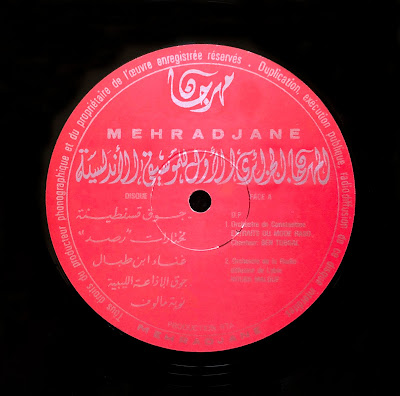ALGERIA – LIBYA
Musique Classique Arabe – 1er Festival Algérien de la Musique Andalouse 1967 / Disc 1 – Mehradjane (LP)
After gaining independence in 1962, the Algerian government wanted to highlight Algeria’s and the Maghreb’s time-honored Arab-Andalusian musical heritage by organizing the first Festival of Arab-Andalusian music at Algiers’ Théâtre National in 1967.
This superb album of live recordings made during the festival (the first volume in a six-LP box set on the Mehradjane label) presents an enticing program of Algerian Nuba – also called Arab-Andalusian classical music – performed by ensembles from the country’s three major Nuba stylistic centers, the cities of Constantine (A1) Algiers (B1-B2) and Tlemcen (B3), plus a rare recording of Nuba performed by a Libyan orchestra (A2). Two more editions of the Festival of Arab-Andalusian music were held in Algiers in 1969 and 1972, with the subsequent release of two additional 10-LP and 12-LP box sets. Here, four orchestras – with lead singers, choruses and instruments including violins, flutes, rebab bowed lutes, ud lutes, quanun zithers, darbuka drums and bendir frame drums – weave poetic, contemplative and spirited ambiances.
The sophisticated civilization that arose in Spain while under Muslim rule embraced and advanced many domains, from science, religion and metaphysics to poetry, music, architecture and the arts, at a time when cities like Cordoba, Seville and Granada were home to Moorish, Arabic, Hispanic, Christian and Jewish cultures in a spirit of openness and tolerance.
Following the Reconquest of the Iberian Peninsula in the 15th century, this musical heritage of a golden age migrated to North Africa, where it continued to thrive and in time became an intrinsic part of the Maghreb’s identity.
Après l’indépendance de l’Algérie en 1962, le gouvernement algérien chercha à mettre en valeur le patrimoine musical arabo-andalou d’Algérie et du Maghreb en organisant un Festival de musique arabo-andalouse en 1967 au Théâtre National d’Alger.
Ce superbe album de concerts enregistrés pendant le festival (le 1er volume d'un coffret de six disques publiés sur le label Mehradjane) propose un séduisant programme de Nouba algérienne – également appelée musique classique arabo-andalouse – interprétée par des orchestres issus des trois grands centres stylistiques de la Nouba en Algérie, à savoir de Constantine (A1), d’Alger (B1-B2) et de Tlemcen (B3), ainsi qu’un enregistrement rare de Nouba interprétée par un orchestre libyen (A2). Deux nouvelles éditions du Festival de musique arabo-andalouse seront également organisées à Alger en 1969 et 1972 suivi de la sortie de deux coffrets de disques supplémentaires. Ici, les quatre orchestres – comprenant des chanteurs, des chœurs et des instruments notamment des violons, des flûtes, des luths à archet rebab, des luths oud, des cithares quanun, des tambours darbuka et des tambours sur cadre bendir – tissent des ambiances poétiques, contemplatives et dynamiques.
La civilisation sophistiquée née pendant la domination musulmane de Espagne excellait dans de nombreux domaines, allant des sciences à la religion, la métaphysique, la poésie, la musique, l'architecture et les arts, à une époque où des villes comme Cordoue, Séville et Grenade accueillaient et s’enrichissaient des cultures maure, arabe, hispanique, chrétienne et juive dans un esprit d'ouverture et de tolérance.
Suite à la reconquête de la péninsule ibérique au XVe siècle, ce patrimoine musical issu d'un âge d'or migre alors vers l'Afrique du Nord où il continue de prospérer et devient même peu à peu une partie intégrante de l'identité maghrébine.
A1 – Excerpt of a Nuba in Rasd Mode – Istikhbar Moual / Dharani El Haoua / Dharani El Haoua;
L'Orchestre de Constantine Directed by Abdelkader Toumi (1906-2005) / Vocals by Abdelmoumène Bentobal (1928-2004);
ALGERIA
A2 – Excerpts of a Nuba Malouf – Men Iaachaq El Ghozlane;
L'Orchestre de Libye Directed by Hassen El Aribi;
LIBYA
B1 – Excerpts of Neklab Sika – Ana Elladi Bia;
L'Orchestre de la Société des Concerts du Conservatoire d'Alger Directed by Abderrezak Fekhardji (1911-1984) / Vocals by Mohamed Khaznadji (b. 1929);
ALGERIA
B2 – Excerpts of Nesraf Dil – Aii Sabab;
L'Orchestre de la Société des Concerts du Conservatoire d'Alger Directed by Abderrezak Fekhardji / Vocals by Mohamed Khaznadji;
ALGERIA
B3 – Excerpt of a Nuba in Sika Mode – Soltane Errabi & Ama Teftaker Îa Ghazali;
L'Orchestre de Tlemcen / Vocals by Mohamed El Ghomeiri;
ALGERIA
Our other Algerian Nuba posts:
Mohamed Tahar Fergani – El Khaima & Ya Mesiene Anabi – Sawt El Menyar 1004 here
Mohamed Khaznadji Musique Classique Algérienne – Noubat Ed Dhil – Les Artistes Arabes Associés 72830 here
Please help me purchase important traditional records
to pursue my global curation project and
share the best finds with you on this blog:
%209%2070.jpg)
%200%2064.jpg)
%2018%2080.jpg)

%200%2024.jpg)
%20-23%2067.jpg)
%20-18%2045.jpg)
%20-12%2064.jpg)
%20-11%2094.jpg)
%20-58%20100.jpg)
%20-48%2080.jpg)
%20-28%2074.jpg)
%20P%20darken%20man%205%2080.jpg)